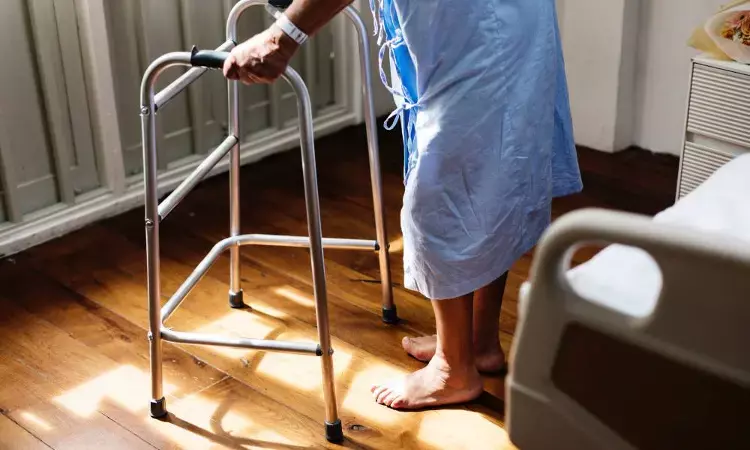- Home
- Medical news & Guidelines
- Anesthesiology
- Cardiology and CTVS
- Critical Care
- Dentistry
- Dermatology
- Diabetes and Endocrinology
- ENT
- Gastroenterology
- Medicine
- Nephrology
- Neurology
- Obstretics-Gynaecology
- Oncology
- Ophthalmology
- Orthopaedics
- Pediatrics-Neonatology
- Psychiatry
- Pulmonology
- Radiology
- Surgery
- Urology
- Laboratory Medicine
- Diet
- Nursing
- Paramedical
- Physiotherapy
- Health news
- Fact Check
- Bone Health Fact Check
- Brain Health Fact Check
- Cancer Related Fact Check
- Child Care Fact Check
- Dental and oral health fact check
- Diabetes and metabolic health fact check
- Diet and Nutrition Fact Check
- Eye and ENT Care Fact Check
- Fitness fact check
- Gut health fact check
- Heart health fact check
- Kidney health fact check
- Medical education fact check
- Men's health fact check
- Respiratory fact check
- Skin and hair care fact check
- Vaccine and Immunization fact check
- Women's health fact check
- AYUSH
- State News
- Andaman and Nicobar Islands
- Andhra Pradesh
- Arunachal Pradesh
- Assam
- Bihar
- Chandigarh
- Chattisgarh
- Dadra and Nagar Haveli
- Daman and Diu
- Delhi
- Goa
- Gujarat
- Haryana
- Himachal Pradesh
- Jammu & Kashmir
- Jharkhand
- Karnataka
- Kerala
- Ladakh
- Lakshadweep
- Madhya Pradesh
- Maharashtra
- Manipur
- Meghalaya
- Mizoram
- Nagaland
- Odisha
- Puducherry
- Punjab
- Rajasthan
- Sikkim
- Tamil Nadu
- Telangana
- Tripura
- Uttar Pradesh
- Uttrakhand
- West Bengal
- Medical Education
- Industry
Case of enterocutaneous fistula following hernia repair surgery

Nepal: Enterocutaneous fistula is a frequent complication following surgery. However, a few cases of hernia strangulation have been observed, predominantly femoral due to the thin femoral ring through which this form of hernia travels. A femoral hernia, accounting for around 20% of all abdominal hernias in females and 5% in males. This paper explored the creation of spontaneous fecal fistulas because there is relatively little research on the subject; the findings were published in BMC Surgery.
A multiparous 72-year-old female arrived at the Emergency Department of Nepal Medical College and Teaching Hospital with a history of on and off groin swelling for the previous two months, which had become irreducible in the ten days preceding presentation. She had no history of nausea, vomiting, fever, colicky stomach discomfort, or distention. However, three days before her visit, she observed that the skin around the bulge had become red and was oozing purulent material. The next day, there was fecal matter discharged from the bulge.
Her vitals were stable at the time of presentation, and there was no sign of peritonitis on physical examination. She did not have any obstruction characteristics, however, she did have an enterocutaneous fistula in her right groin. There were no swellings in the groin or umbilicus on the left side. The fistula was of poor production and was observed to discharge fecal particles. In addition, there was no evidence of sepsis or the need for inotropic support over the course of therapy.
The patient was hospitalized, resuscitated, and a contrast-enhanced computed tomography scan was performed, which revealed findings consistent with an enterocutaneous fistula exiting the femoral ring. The femoral ring was repaired using polypropylene sutures from the groyne incision and intraperitoneally (mesh was not used in this patient), and the skin was maintained open. The post-operative time went smoothly, and the patient was released on post-op day 5, with the skin incision closed with polyamide sutures and the drain removed on the same day.
In conclusion, most patients who appear in this setting are impoverished, lack the necessary level of expertise for timely consultations, and postpone their health care until an emergency occurs. These variables may have a part in the creation of such fistulae, even though in our day and age, such problems may be readily avoided with prompt procedures. Even delayed presentations, like in this example, can be managed by adhering to a set of predefined standards, such as the SNAP guideline.
Reference:
Chalise, A., Rajbhandari, A.P., Kathayat, L.B. et al. Spontaneous enterocutaneous fistula in a patient with femoral hernia: a case report. BMC Surg 21, 435 (2021). https://doi.org/10.1186/s12893-021-01439-1
Medical Dialogues consists of a team of passionate medical/scientific writers, led by doctors and healthcare researchers. Our team efforts to bring you updated and timely news about the important happenings of the medical and healthcare sector. Our editorial team can be reached at editorial@medicaldialogues.in.
Dr Kamal Kant Kohli-MBBS, DTCD- a chest specialist with more than 30 years of practice and a flair for writing clinical articles, Dr Kamal Kant Kohli joined Medical Dialogues as a Chief Editor of Medical News. Besides writing articles, as an editor, he proofreads and verifies all the medical content published on Medical Dialogues including those coming from journals, studies,medical conferences,guidelines etc. Email: drkohli@medicaldialogues.in. Contact no. 011-43720751


